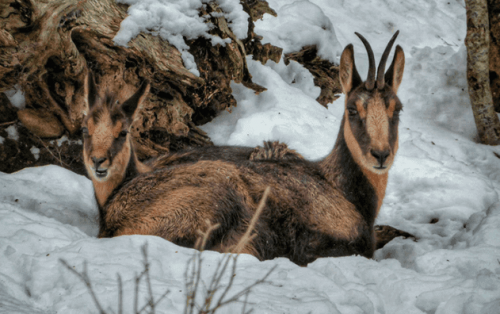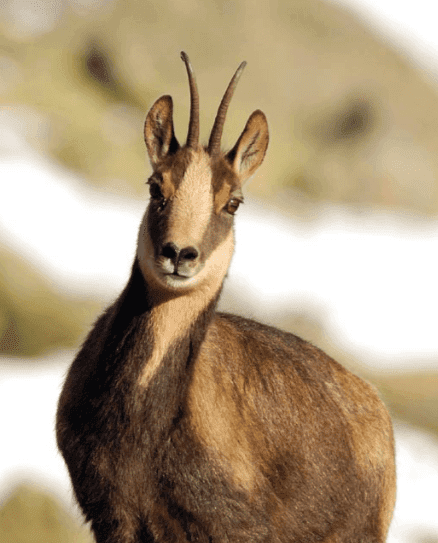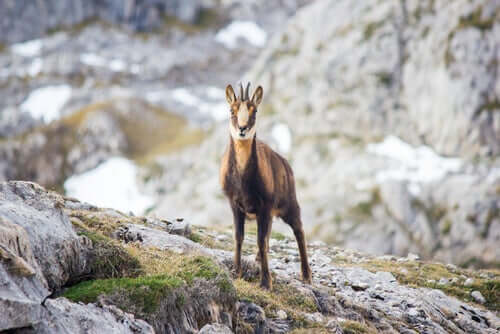What Is the Mysterious Pyrenean Chamois?

The Pyrenean chamois is one of the least known of all the wild ungulates that inhabit the European mountains. In today’s article, we’re going to give you a brief summary of who this mysterious animal is.
Pyrenean chamois
The Pyrenean chamois is a subspecies of the Central European chamois, which cohabits with the Cantabrian subspecies (Rupicapra rupicapra parva) in the Pyrenees region. Its scientific name is Rupicapra rupicapra sub sp. Pyrenean
People also know these animals as sarrio in the Aragonese Pyrenees, but in other areas they also call them chizar or icharzo.
The location of their habitat is at an altitude of between 4900 and 10000 feet, but they move to lower levels during the winter. Like all cervids, they’re social animals and form groups of males and females together with their calves.
Adults weigh between 44 and 88 pounds and can live up to 20 years.
Unlike other cervids, both the male and female of the Pyrenean chamois have horns. Even though they can be quite similar in height, the female’s horns are somewhat thinner, grow more parallel and have a less marked curvature. The fur has earth tones and gets slightly reddish during the summer.

They mainly inhabit the Pyrenees, Cantabrian Mountains, and the Apennine Mountains.
This is an exclusively herbivorous animal. In addition, their heat happens between November and the beginning of December. Generally, calves are born during the second half of May through the beginning of June.
The female births a single calf or, very rarely, twins.
Status and management of the species in the Pyrenees
The distribution of the population of chamois is in large part through the massifs of the Pyrenees and in some mountains belonging to the Pre-Pyrenees. The national game reserves in charge of the Generalitat of Catalonia manage most of this population and they also protect the specimens who live in the national park.
The historical evolution of this population shows an upward trend, which allows its hunting.
One of the difficulties faced by the growth of this species in the Pyrenees is the appearance of a disease caused by a pestivirus. People know it as “border disease,” and it has led to many deaths since 2001. So, this, in turn, led to changes in the management of the species, which led to a hunting prohibition for a season.

With the goal of having objective data in regard to the species in the area, the Catalan Pyrenees has been carrying out a monitoring program of the chamois since 2001. This program includes censuses and data collection of specimens that people killed during hunting. They also included those they just found dead, as well as carrying out population management by sectors.
Status and management of the Pyrenean chamois in Navarra
This population lives in the Larra-Belagua valley and the massifs of Ezkaurre and in the Ori-Lakartxela tailpiece. It’s a small population in general. It’s also in good health and has demographic characteristics of low-density populations and forested environments.
People have monitored this population since the 1990s and observed an increase in the number of specimens since then.
Status and management of the Pyrenean chamois in Aragon

Since 1995 a series of actions carried out by the Government of Aragon has enabled the authorities to consolidate the management of the chamois’ hunting reserves in the Aragonese Pyrenees. In fact, they instituted 16 management units constituted by mountainous massifs. And, in addition to that, they also carried out population estimates in each of them.
Thank you for reading.
All cited sources were thoroughly reviewed by our team to ensure their quality, reliability, currency, and validity. The bibliography of this article was considered reliable and of academic or scientific accuracy.
- Sarrio [Internet]. Enciclopedia-aragonesa.com. [cited 18 September 2019]. Available from: http://www.enciclopedia-aragonesa.com/voz.asp?voz_id=11551
- Sarrio [Internet]. Es.wikipedia.org. 2019 [cited 18 September 2019]. Available from: https://es.wikipedia.org/wiki/Rupicapra_pyrenaica
- Herrero J, Escudero E, Fernández de Luco D, García-González R. El sarrio pirenaico. 3rd ed. Consejo de Protección de la Naturaleza de Aragón. Pag.: 79-87
